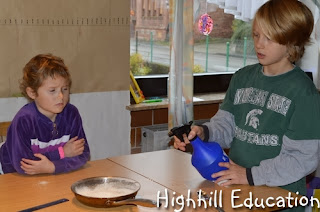Earth Science Unit Study
Week 13: We learned about deserts, measured the diameter of rain drops and did a project to demonstrate how rain drops form around specks of dust in the atmosphere.In How the Earth was Made - Sahara, scientists search for clues to unlock the secrets of the Sahara desert. Scientists believe that since the Earth rotates on it's access, every 20,000 years, there are major shifts in the locations of the Earth's deserts. Nummulite, tiny ancient sea creatures, were found in the blocks used to construct the pyramids. Bones of extinct whales have been found throughout the desert. Both of these clues indicate the desert was once a great sea.
In the video the Baking Deserts, scientist also point to the evidence proving that the desert was once a sea. Cypress trees estimated to be 3000 years old still live today in the desert. Cave art showing antelope, giraffe and cattle has been found in the Sahara.
In addition, David Attenborough describes how several desert plants and animals have adapted to survive in the harsh environment. Animals such as rabbits and foxes have extra long ears which act as cooling fins. Birds learn to breath in a special way which helps them keep cool. Squirrels use their tails as umbrellas to shield them from the sun. Some plants coat their leaves with salt to reflect heat. Others, such as American cactus, have turned their leaves into thorns and use the stem for photosynthesis.
Since rain is scarce in the desert, both projects centered on rain. In the first project, the diameter of different types of rain was determined. In the second, rain droplets were formed around crystals of salt. Both activities came from the book Janice VanCleave's A+ Projects in Earth Science: Winning Experiments for Science Fairs and Extra Credit
Thundershowers, mist, and drizzle all describe different types of rain, and each type has unique characteristics. One trait scientists use to distinguish between types of rain is the diameter of the droplets.
We began by sifting flour into a pan and using a spray bottle to simulate rain.
Next the rain drops were scooped out of the flour and sifted again to be collected.
After they were collected, they were viewed on a dark background through a magnifying glass and measured.
Finally the pan was placed in the rain so actual rain drops could be collected. These were measured and compared with the spray bottle drops.
High in the atmosphere, rain drops form by condensing onto specks of dust. To simulate this process, a few grains of salt were placed in a humid environment and observed to see if drops of water condensed onto them.
A dark sheet of construction paper was cut to fit inside a lid of an old container. The dark color made it easier to view the salt.
Next, the paper was smeared with petroleum jelly to prevent water absorbing into the paper and a few grains of salt were placed on top of the paper.
A small amount of water was placed in the pan, the lid was floated on the water, and covered with a slightly larger container.
After a few hours water droplets formed on the salt crystals. The water droplets continued to grow, and by the next day had doubled in size.
Kids learn in so many different ways - reading, visually and hands-on projects used in combination allow kids to gather similar information presented in various formats and make sense of it in their own way. To see more of our Earth Science Projects please visit our Science Page.











I just love your earth science activities - thanks so much for sharing them, they offer lots of inspiration!
ReplyDelete